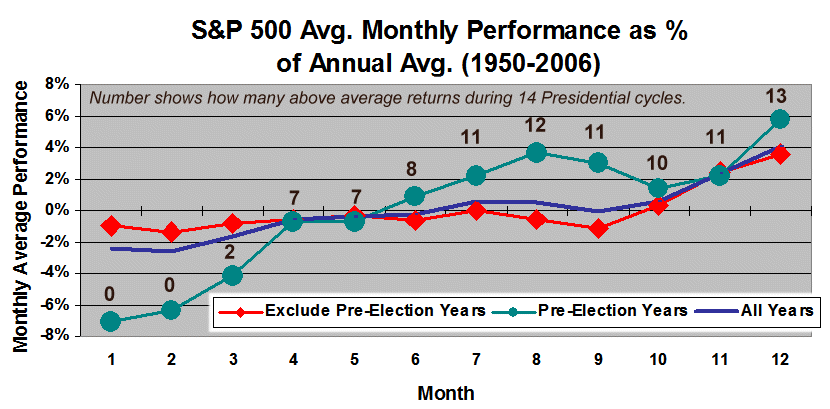TripleScreenMethod.com
Cycles in the Market: The Monthly Cycle for the S&P 500 (1950-2006)
Richard W. Miller, Ph.D.

Cycles abound in the market. From intraday to decennial frequencies, cycles have been identified and written about. See Larry William’s “The Right Stock and the Right Time,” for example, and Jeffrey Hirsch’s “Stock Trader’s Almanac.” One in particular, though, makes theoretical sense and, at the same time, can be supported statistically: the pre-election year S&P 500 return in the Presidential cycle has averaged +16.5% with16-of-16 positive years between 1940 and 2006, while election, post-election and midterm years returned on average 7.0, 3.7 and 5.3%, respectively. Clearly, the dynamic of a pre-election year—like 2007—is different as those holding power support economic policies favorable to the economy and commercial profits.
Another cycle Hirsch has written about extensively is the six-month cycle. It’s embodied in the statement: “go away in May.” Investing two $10,000 lots in the Dow 30 and segregating each into six-month periods was eye opening. Between 1950 and 2006, investing in the Dow 30 stocks between May 1 to October 31 and cash otherwise reduced its $10,000 to $9,728, while investing solely in the November 1 to April 30 period increased that $10,000 to $515,480. Impressive, but the Dow index suffers two inadequacies: it’s a price, not market cap, weighted index, and it’s limited to just 30 stocks. Ken Fisher in his best seller, “The Only Three Questions That Count,” explains why a price-weighted index, like the Dow or NIKKEI, paints a totally inaccurate picture of the market. Let’s look at how the S&P 500, a market-cap weighted index has performed over the same time period.
The accompanying chart shows how the S&P 500—and the market generally--varied over the 1950-2006 period. Pre-election years are segregated for the 14 Presidential cycles, and each month’s close relative to index’s annual average is charted as a percentage change. Two points are obvious: (1) pre-election years, like 2007, behave differently than the other three in the election cycle, and (2) June-through-December offered above average returns for the year.
Putting these data in a little more perspective, the probability of getting above average performance in 13 of 14 pre-election years if there were no positive bias, i.e., if there were a 50-50 chance (like flipping a fair coin and getting 13 of 14 heads) would be 0.000854 or one chance in 1170. Other probabilities are as follows: 12 of 14 (0.005554), 11 of 14 (0.022217) and 10 of 14 (0.061096). Summarizing, there is a high probability in pre-election years that the market reflects a positive bias for the latter half of the year. As Ken Fisher suggests in his most recent quarterly report, the rest of 2007 should indeed be bullish.